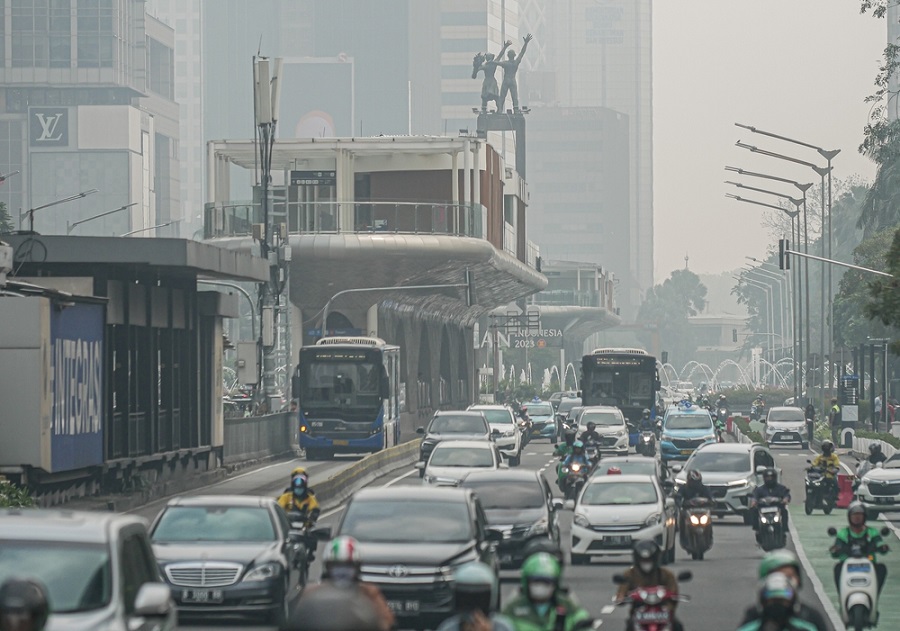Quick Summary
- Older adults are highly vulnerable to climate-related health risks like heat waves, air pollution, and water issues.
- Extreme heat increases hospital visits, especially among seniors with multiple pre-existing health conditions.
- Climate change is already impacting health, not just in the future but now, with more visible effects each year.
- Clean water access and air quality are becoming less stable, creating added risks for at-risk populations.
- Health systems and policymakers must act, focusing on global health prevention, better infrastructure, and targeted support for older adults.
A walk outside shouldn't come with a health warning, but for many older adults, air pollution can harm their health.
Aging changes how our bodies work. The lungs become less efficient, the heart weakens, and the immune system slows down. These age-related changes decrease the body's capacity to handle harmful particles in the air. Add pre-existing health conditions like cardiovascular disease or obstructive pulmonary disease, and even moderate pollution levels can trigger serious problems.
Older adults are also more sensitive to environmental stressors. What may bother a younger person can lead to hospital visits or long-term human health problems for someone over 65. Many older adults spend more time indoors, but indoor air can also be unsafe, especially in places where outdoor pollution seeps inside.
This growing vulnerability means that health risks from air pollution are not just about city planning. They directly affect older people. Human health professionals and policymakers need to understand how environmental issues relate to aging and take necessary steps.
This blog will discuss the link between climate change and health, how air pollution affects older adults, and what steps can be taken to reduce their health risks.

Air Pollution and Its Sources
Air pollution refers to harmful substances in the air that people breathe. The most common pollutants include particulate matter (PM2.5), ground-level ozone, nitrogen dioxide, and sulfur dioxide. These particles and gases come from various sources, including vehicles, factories, power plants, and household burning.
Urban areas often experience higher levels of air pollution as a result of traffic congestion and industrial activity. In contrast, rural areas have lower pollution levels but can still be affected by farming equipment, wildfire smoke, or wind-blown pollutants from cities. The type and level of environmental exposures depend on where someone lives and the environmental factors around them.
Greenhouse gas emissions also affect the air quality. While gases like carbon dioxide don't directly cause illness, they contribute to climate change, which worsens air pollution through heat waves, wildfires, and stagnant air conditions.
Health Effects of Air Pollution on Older Adults
Senior citizens have a greater risk of health problems from air pollution due to changes that come with human aging. As people age, the body's ability to fight illness and recover from damage slows down. This makes older individuals more sensitive to the harmful particles and gases in the air.
Prolonged exposure to air pollutants increases the risk of cardiovascular disease. This is especially true for people over the age of 65. A study's findings have linked fine particulate matter (PM2.5, PM10, and PM1) with rising rates of premature deaths caused by heart and lung disease in aging populations, especially in high-income countries. The same pollutants are also strongly tied to chronic obstructive pulmonary disease (COPD) and even worsen symptoms for those who already have it.
In addition to the lungs and heart, air pollution affects the immune system. Weakened immunity in older adults increases their chances of catching infectious diseases like pneumonia or bronchitis. Poor air quality can also worsen existing chronic diseases such as diabetes or kidney conditions, making overall recovery more difficult.
There is also a strong connection between air pollution and mental health. Fine particles in the air may trigger inflammation in the brain, which increases the risk of depression or cognitive decline. For older adults living alone or with limited access to care, these changes can go unnoticed and untreated.
Air pollution causes sickness and leads to more visits to emergency rooms and longer hospital stays. It also harms our overall environmental health. It also makes infectious diseases spread faster in communities with high pollution levels and aging populations.
Mental and Cognitive Health Impacts
Air pollution doesn't just harm the lungs' capacity. It also affects the brain, especially in older adults. Exposure to polluted air is linked with increased rates of anxiety, depression, and cognitive decline. These changes are not always easy to notice immediately, but can lead to serious issues over time.
Contaminants can enter the blood and reach the brain. Once there, they may cause inflammation, which has been tied to memory loss and early signs of dementia. This process contributes to what researchers call environmental aging, where outside factors like pollution accelerate the natural effects of aging on the body and mind.
Older adults are susceptible to these changes. Their bodies process environmental exposures differently from younger people. If they're already living with chronic conditions, mental changes often make those problems harder to manage. For example, someone with heart disease who also experiences depression may struggle to follow treatment plans or attend appointments.
Mental well-being and physical well-being are closely intertwined. One often affects the other. When air pollution impacts both, it creates a double strain on the body. This can worsen health outcomes, including a faster decline in daily functioning and quality of life.
Social and Environmental Determinants of Health in Older Adults
Health in older adults is shaped by more than age or genetics. Environmental and social determinants play a major role in how well someone ages. These include where a person lives, their income level, and access to care and support.
Older adults with lower socioeconomic status often face greater health risks. Limited income may restrict access to safe housing, nutritious food, or secure transport. Many also live in areas with higher air pollution levels, increasing the illness burden over time.
Location makes a difference. Urban neighborhoods also face heavy traffic, industrial pollution, or noise. Others in rural areas may lack nearby healthcare services. Both environmental and social factors affect the support systems that older adults depend on as they age.
Climate hazards are increasing concerns. Aging adults are more likely to be harmed during floods, wildfires, or poor air quality. Their bodies do not adjust well to temperature changes, making them especially vulnerable during extreme weather events. These periods can worsen existing human health problems and make recovery harder.
Rise of Water-Related Illnesses
Water-related illnesses are on the rise, and climate change is a key reason. As global warming drives changes in temperature and precipitation patterns, the systems we rely on for clean water are becoming less stable. This puts more people at risk of getting sick, especially in places with poor sanitation or weak infrastructure.
The World Health Organization reports that climate change presents a growing threat to safe water. Floods can carry harmful bacteria into drinking water, while droughts reduce the clean water supply and make contamination worse.
One study found that climate shocks, such as sudden weather changes tied to climate change, have led to more waterborne diseases in low- and middle-income countries. These outbreaks, including diarrhea-related illnesses, are especially common among people already vulnerable to health problems.
Climate risks aren't limited to poorer regions. Human-induced climate change is also affecting water safety in wealthier countries. Higher heat can lead to toxic algal blooms in lakes, making water unsafe to drink or swim in. Warmer coastal waters also breed bacteria like Vibrio, which can cause serious infections.
The global climate crisis impacts more than the environment. It puts public health at risk. Older adults and people with chronic illnesses are more likely to suffer from the health effects of unsafe water. Heatwaves and a lack of clean water can lead to dehydration, infections, and hospital visits.
Recent research underscores this vulnerability: analyzing 8.7 million emergency department visits in California, they found that extreme heat events significantly increased hospital visits among adults aged 65 and older. A single day of extreme heat (above the 99th percentile) raised the odds of an emergency visit by 4%, while a two-day heatwave raised them by 4.4%.
The risk was even greater for frail seniors with multiple chronic conditions, who faced 8.5% higher odds of visiting the ER during the hottest days. This demonstrates how climate-driven heat spikes can directly trigger acute health crises, particularly when combined with poor water access, dehydration, or exposure to contaminated water.
As climate change continues, these risks will grow. More frequent climate hazards and shifting weather patterns will pressure our water systems. Without better planning and stronger infrastructure, the impact on health outcomes will only get worse.

Need for Health System Reform to Address Air Pollution Among Older Adults
Air pollution continues to place a burden on public health, especially for aging populations. As the effects of poor air quality intensify, health systems worldwide are facing rising demands. Older citizens are more prone to suffer from chronic respiratory and cardiovascular conditions, which are made worse by long-term exposure to polluted air.
Health services are feeling the strain. More hospital admissions, longer treatment times, and higher care costs are becoming common in areas with poor air quality. Health professionals are managing more pollution-related illnesses, leaving the health workforce stretched thin. This pressure reduces the time and resources available for prevention and early intervention.
Many health systems were not designed to respond to environmental threats on this scale. As air pollution becomes more persistent, climate-informed surveillance has become a necessity. Health emergencies linked to pollution require quick, coordinated responses. A lack of data and slow reaction times put vulnerable groups, especially older adults, at greater risk.
The health sector needs stronger policies to prepare for ongoing and future challenges. National health planning must now include environmental factors. Climate resilience should not be optional. Health priorities must shift to account for growing risks tied to pollution and climate instability. Without this shift, we risk potentially reversing decades of progress in disease prevention and quality care delivery.
Universal health coverage plays a key role. Older adults often face barriers to care, including limited income, mobility issues, or gaps in insurance. A system that can provide universal health coverage ensures that care remains accessible, regardless of age or location. This means investing in primary health care, expanding community clinics, and ensuring services are located where older populations live.
Reforming the health system isn't just about capacity. It's also about health equity. Disadvantaged communities often live in areas with the worst air pollution and have the fewest resources to seek care. Any reform that ignores this will fall short. Health services must be designed with these groups in mind, not as an afterthought but as a priority.
To move forward, we need long-term investments, cross-sector partnerships, and workforce training that equips health professionals for environmental challenges. Only then can health systems offer reliable care for older adults and respond to future risks with agility and confidence.
How to Control the Impact of Air Pollution on Older Adults and the Public?
Air pollution affects everyone, but older adults face greater risks. A weaker immune system and chronic health issues make it harder for them to recover from exposure. As pollution levels rise and global temperatures increase, public health strategies must adjust to protect people of all ages.
One way to reduce harm is through climate-resilient planning. Cities and governments can take action by improving air quality monitoring, setting up early warning systems, and developing stronger response plans. These measures help communities, especially those with existing health problems, avoid the worst effects of polluted air.
To make real progress, different sectors need to work together. Key areas affecting health, like energy, transportation, and housing, are important for overall well-being. People must switch to cleaner fuels, improve urban design, and lower emissions to reduce pollution and improve daily living conditions.
The health community also plays an important part. Health professionals must learn to spot pollution-related symptoms early and educate patients about prevention. They can also push for policy changes that support climate-resilient health services and protect people at greater risk.
Another step is building environmentally sustainable health systems. Hospitals and clinics can reduce their impact by using clean energy, managing waste better, and designing energy-efficient buildings. These changes also support low-carbon health systems, lowering emissions from within the health sector.
A shift toward environmental sustainability doesn't just help the planet, it improves health outcomes. Cleaner operations in the health sector protect limited resources, reduce pollution, and create safer care environments.
To protect public health in the long term, we need collaboration. Policymakers, public health leaders, and the wider community must work together. By making smarter decisions and reducing air pollution, we can protect the health of older adults and support healthier lives for everyone.
Conclusion
Older adults face growing health risks as climate change continues to accelerate. Rising temperatures, worsening air pollution, and shifting weather patterns already affect public health. The most serious health impacts often fall on those with limited mobility, chronic illness, or reduced access to clean air and water.
Action is needed across all levels to make sustainable progress. Individuals can stay informed and take personal steps to reduce exposure. But broader change requires stronger policies, better infrastructure, and more responsive health systems.
Male Excel is committed to supporting men's health through this changing environment. If you're noticing fatigue, low energy, or poor recovery, it may be time to check your hormone levels. Our testosterone therapy and hormone treatments help men age well, even as the world around us shifts.
References
1. Guo, J., Chai, G., Song, X., Hui, X., Li, Z., Feng, X., & Yang, K. (2023). Long-term exposure to particulate matter on cardiovascular and respiratory diseases in low- and middle-income countries: A systematic review and meta-analysis. Frontiers in Public Health, 11. https://doi.org/10.3389/fpubh.2023.1134341
2. Levy, K., Smith, S. M., & Carlton, E. J. (2018). Climate change impacts on waterborne diseases: Moving toward designing interventions. Current Environmental Health Reports, 5(2), 272-282. https://doi.org/10.1007/s40572-018-0199-7
3. Santodomingo, M., Castillo, E. M., Schwarz, L., Brennan, J. J., Benmarhnia, T., & Chan, T. C. (2024). Extreme Heat Events and Emergency Department Visits among Older Adults in California from 2012-2019. Medicina, 60(10), 1593. https://doi.org/10.3390/medicina60101593

Get TRT Online
Optimize Your Hormones





